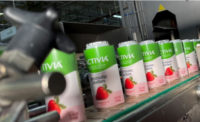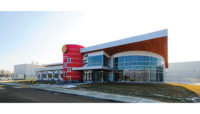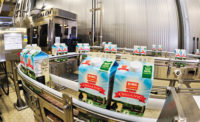Dairy Foods has a long tradition of devoting part of the August issue to our “Plant of the Year” winner. Previously, we’d nominate only the dairy plants we’d profiled in the past 18 months, and allowed readers to choose the winning facility. But this year we decided to do things a little differently: We opened up nominations to any exceptional U.S. dairy plant.
To win the award, the plant must have achieved outstanding accomplishments in one or more of the following categories between Jan. 1, 2020, and June 1, 2021: plant expansion/retrofit, new construction, sustainability food safety, employee safety, employee training programs, plant efficiencies, coronavirus-related efforts, new technology and/or other specified area(s) of excellence.
We’re pleased to announce that the 2021 Dairy Foods Dairy Plant of the Year is St. Johns, Mich.-based MWC. The plant, which is a joint venture among Glanbia Nutritionals, Select Milk Producers Inc. and Dairy Farmers of America Inc. (DFA), not only demonstrates excellence in one of our nomination categories, but also boasts accomplishments in nearly all of them.
Shambaugh & Son L.P., a Fort Wayne, Ind.-based construction and design firm that worked with the joint venture to create the plant on a greenfield site, nominated MWC.
“It's actually a pretty great honor to have won this award … and to be able to accept this on behalf of the Glanbia team and all those that helped bring this together,” says George Chappell, senior vice president of dairy operations for Chicago-based Glanbia Nutritionals.
Building something new
According to Chappell, MWC is the second plant operated by the joint venture. The companies also collaborate to operate Southwest Cheese, a facility in Clovis, N.M., and saw an opportunity to expand the successful business model. (Kansas City, Kan.-based DFA and Dallas-based Select Milk Producers provide the milk supply, and Glanbia operates the facilities and markets the products.)
“Glanbia was continuing to look for ways to expand their geographic foothold by cheese and whey production in the U.S., and … DFA and Select had excess milk in the Michigan area,” he points out.
The Michigan site was two years in the making, notes Dan Ritzert, senior vice president, Shambaugh & Son. Construction began in 2018, and the plant’s doors opened in October 2020, which means it was partly built during the COVID-19 pandemic.
“To do a greenfield site is difficult — let alone to do a greenfield site during a pandemic,” explains Chappell. “You gotta be proud of the fact that this is one of the smoothest greenfield sites I've ever seen and been part of. You have to be proud of the fact that it was executed during a pandemic and that we never did lose sight of the safety aspect of making sure that people went home as safe as they possibly could.”
Chappell says that he finds the way the building was designed to be one of the most innovative parts of the MWC plant. The joint venture partly selected Shambaugh & Son because the company showed the possibilities of using 3D modeling as a means to precisely construct the facility.
“The precision that the 3D modeling allowed was extraordinary,” he emphasizes. “I mean, we were down to fractions of an inch of where we knew that we needed to place a foothold or do a wall penetration.”
Glanbia wanted to create a facility that met its “success criteria,” notes Chappell, or rather the non-negotiables that the company emphasizes when going into any similar project. These criteria include people safety, food safety, sustainability and housekeeping (sustaining the plant through decades).
“So as we sat down with [Shambaugh], we looked at the different design options that will allow for that to happen — whether it be in finishes, tile finishes, wall finishes, wall penetrations,” Chappell explains. “And we applied that type of thinking throughout the process, but it always came back to the non-negotiables.”
Ritzert notes that “a variety of process modeling, fluid modeling and 3D equipment and piping modeling was used to efficiently plan maintenance access, ease-of-installation and operational workflow with Shambaugh and MWC before starting fabrication and ultimately installing piping and equipment.”
Part of what makes the plant’s construction unique is the joint venture was able to take the top processes and technology from all its plants to create a new facility that utilized what worked the best. Chappell says that he’s particularly excited about the level of automation at MWC, which allows the facility to “graph, to trend, to replay events that took place,” and to easily troubleshoot.
“The equipment that was put in is the state-of-the-art equipment in terms of cheesemaking, whey processing,” he notes. “It's a reapplication of the best of what we know over multiple decades of knowledge that has been developed.”
Innovative cheesemaking, whey processing
The MWC facility is a cheese and whey-processing plant. The cheese produced is sold to other companies to further process it into their own branded or private label retail products or for foodservice; the whey protein concentrates and isolates are sold in bulk to be used in food, beverage, and supplement companies’ consumer products, says Chappell.
“The MWC plant receives 8 million pounds of raw milk through its eight receiving bays and produces approximately 850,000 pounds of superior cheddar, Monterey Jack and colby jack cheeses in either [a] 40-pound or 640-pound block, processing through its 16 cheese vats and two cheese belts each day,” Ritzert notes.
The plant also uses a microfiltration and ultrafiltration process to process and dry whey protein, producing “up to 15,000 pounds per day of whey protein concentrate and 40,000 pounds per day of whey protein isolate powders, which are packaged in 20 kilogram and bulk totes,” he adds.
The plant also collaborates with a nearby facility operated by Proliant Dairy Ingredients, notes Ritzert.
“Whey permeate left from the concentration process is piped at a rate of 200,000 gallons per day to a neighboring plant, operated by Proliant, across a pipe bridge, for drying on the largest permeate spray dryer in North America,” he explains.
The MWC facility processes 25% of the milk produced in Michigan, Ritzert emphasizes, and the plant’s operations ensure that the highest-quality products are manufactured. It also is the largest dairy processor on a single site in the state.
The milk that is received in the facility comes from over 100,000 local cows, he adds. Shambaugh & Son worked with Marshfield, Wis.-based Complete Filtration Resources Inc. to develop a turnkey solution to receive and process raw milk.
“Eight flexible receiving bays receive raw milk through automated mix-proof valve clusters, sending the raw milk to silos where MWC has 560,000 gallons of storage,” he says. “Raw milk is then processed through dual filtration, standardization, and pasteurization lines. Pasteurization and filtration are designed for gentle treatment and standardization of milk prior to cheesemaking.”
The plant itself is 400,000 square feet, and the cheesemaking portion encompasses 46,000 square feet.
“Equipment was painstakingly planned, modeled, and coordinated with Shambaugh to ensure equipment could be placed inside the structure and assembled before the building space was even complete,” Ritzert says. “Interconnecting process piping was coordinated with utilities, and cable tray on massive combined racks [was] suspended from the structure both within the space and leading into and out to the additional 30,000 [square feet] of cheese [clean-in-place], culture storage, secondary packaging and support spaces dedicated to the cheesemaking process.”
Cheesemaking equipment highlights include 16 of the “most modern” Tetra Pak horizontal cheese vats, each of which features the latest seal technology to prevent leakage; two cheese belt systems that have “advanced whey and cheese curd separation technology”; and 16 block formers “redesigned to feature a smaller footprint, hygienic lift system and the latest auto-baggers for 40-pound blocks of cheese,” Ritzert says.
The facility’s whey operations comprise over 43,000 square feet, which includes “12 filtration systems with a total surface area of 65,000 square meters,” he adds.
“The way that we're doing our whey processing is also fairly unique, and again, state of the art,” Chappell notes.
According to Ritzert, the whey processing system was designed to recover approximately 95% of the water from each day’s whey operations and convert it to Category 1 water, which is used throughout the plant.
Chappell explains that by the time water reaches the wastewater treatment plant, it has been used multiple times for various purposes. The water also is turned into nearly potable water by the time it leaves the facility to meet Michigan’s standards.
“So if you look at the entire environmental cycle from water-in to water-out you'd look at it and it's almost a ‘leave no trace,’” he remarks.
Focus on safety, sanitation
According to Chappell, the plant also was built to emphasize food safety and sanitation.
“Shambaugh constructed approximately 220,000 square feet of major processing areas from 100% precast concrete to ensure a robust and sanitary design,” Ritzert explains.
The company paid attention to hard-to-clean areas when designing the plant, he adds. This included embedding electrical boxes and conduits into the precast walls “to eliminate miles of vertical conduits along walls.”
Ritzert points out that “racks were welded to embeds in the bottom of precast elements, rather than floor supporting, to further eliminate hard-to-clean areas; this provided zero room for error.”
According to Chappell, the joint venture designed its operations in a way where it is inherently producing a food-safe product through the equipment used and the infrastructure of the plant, and the facility does daily cleaning shifts.
“Our process is such that every 24 hours we're taking down the equipment and washing and doing external and internal cleaning,” he notes.
The joint venture chose equipment with an automated sanitation process, where operators essentially just need to press a button to begin the cleaning, and the technology self-monitors to ensure proper sanitation took place.
“It's almost like a NASCAR crew,” Chappell says. “You run the equipment hard and then when you shut down everything comes down, and we clean quickly, and then we bring it back up again.”
Ready for the future
Chappell explains that the ability to expand MWC was one of the main success criteria when constructing the facility.
“Where we could and it was a nominal increase in costs, we went in and went ahead and built a capacity piece,” he adds. “The other pieces that we knew are more modular where we could knock out a wall and add some more equipment that was designed in as well.”
While the plant has been open only since October, there already has been an increase in capacity. MWC used a “ramp-up process” in terms of quantity of products produced, says Chappell.
“When we opened the doors in October 2020, our plan from then was every month we would increase our milk production by a million pounds of milk … per month,” he notes. “So in October, November, we were running roughly 1 million pounds of milk, and then we'd increase by another million pounds of milk every 30 days or so.”
Mid-May was the first time the plant ran 8 million pounds of milk, which was the initial criteria for the plant, Chappell notes.
“So at this stage, it's about getting the plant settled down, getting consistency with what we have, but inevitably there's two things that will drive an expansion. It's demand for product and milk production,” he adds. “So although there isn't anything formally discussed yet, there [have] already been some discussions around what would it take without a lot of detail behind future expansion.”












